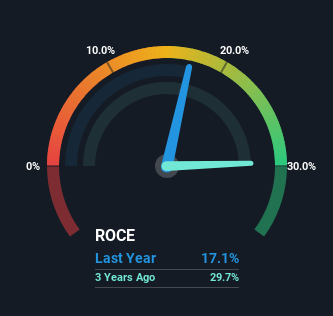Be Wary Of Shanghai Bolex Food Technology (SHSE:603170) And Its Returns On Capital

There are a few key trends to look for if we want to identify the next multi-bagger. In a perfect world, we'd like to see a company investing more capital into its business and ideally the returns earned from that capital are also increasing. If you see this, it typically means it's a company with a great business model and plenty of profitable reinvestment opportunities. However, after investigating Shanghai Bolex Food Technology (SHSE:603170), we don't think it's current trends fit the mold of a multi-bagger.
What Is Return On Capital Employed (ROCE)?
For those who don't know, ROCE is a measure of a company's yearly pre-tax profit (its return), relative to the capital employed in the business. Analysts use this formula to calculate it for Shanghai Bolex Food Technology:
Return on Capital Employed = Earnings Before Interest and Tax (EBIT) ÷ (Total Assets - Current Liabilities)
0.17 = CN¥265m ÷ (CN¥2.0b - CN¥431m) (Based on the trailing twelve months to June 2024).
So, Shanghai Bolex Food Technology has an ROCE of 17%. In absolute terms, that's a satisfactory return, but compared to the Food industry average of 6.8% it's much better.
Check out our latest analysis for Shanghai Bolex Food Technology

In the above chart we have measured Shanghai Bolex Food Technology's prior ROCE against its prior performance, but the future is arguably more important. If you'd like to see what analysts are forecasting going forward, you should check out our free analyst report for Shanghai Bolex Food Technology .
What Does the ROCE Trend For Shanghai Bolex Food Technology Tell Us?
When we looked at the ROCE trend at Shanghai Bolex Food Technology, we didn't gain much confidence. Around five years ago the returns on capital were 41%, but since then they've fallen to 17%. Although, given both revenue and the amount of assets employed in the business have increased, it could suggest the company is investing in growth, and the extra capital has led to a short-term reduction in ROCE. And if the increased capital generates additional returns, the business, and thus shareholders, will benefit in the long run.
On a side note, Shanghai Bolex Food Technology has done well to pay down its current liabilities to 22% of total assets. That could partly explain why the ROCE has dropped. What's more, this can reduce some aspects of risk to the business because now the company's suppliers or short-term creditors are funding less of its operations. Some would claim this reduces the business' efficiency at generating ROCE since it is now funding more of the operations with its own money.
The Key Takeaway
In summary, despite lower returns in the short term, we're encouraged to see that Shanghai Bolex Food Technology is reinvesting for growth and has higher sales as a result. These growth trends haven't led to growth returns though, since the stock has fallen 29% over the last year. As a result, we'd recommend researching this stock further to uncover what other fundamentals of the business can show us.
If you'd like to know more about Shanghai Bolex Food Technology, we've spotted 2 warning signs, and 1 of them makes us a bit uncomfortable.
While Shanghai Bolex Food Technology may not currently earn the highest returns, we've compiled a list of companies that currently earn more than 25% return on equity. Check out this free list here.
New: Manage All Your Stock Portfolios in One Place
We've created the ultimate portfolio companion for stock investors, and it's free.
• Connect an unlimited number of Portfolios and see your total in one currency
• Be alerted to new Warning Signs or Risks via email or mobile
• Track the Fair Value of your stocks
Have feedback on this article? Concerned about the content? Get in touch with us directly. Alternatively, email editorial-team (at) simplywallst.com.
This article by Simply Wall St is general in nature. We provide commentary based on historical data and analyst forecasts only using an unbiased methodology and our articles are not intended to be financial advice. It does not constitute a recommendation to buy or sell any stock, and does not take account of your objectives, or your financial situation. We aim to bring you long-term focused analysis driven by fundamental data. Note that our analysis may not factor in the latest price-sensitive company announcements or qualitative material. Simply Wall St has no position in any stocks mentioned.
About SHSE:603170
Shanghai Bolex Food Technology
Engages in the research, development, production, and sales of condiments and pre-cooked food in China and internationally.
Flawless balance sheet and good value.
Market Insights
Community Narratives



